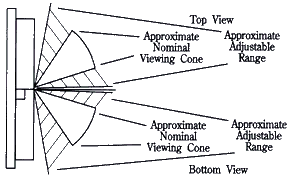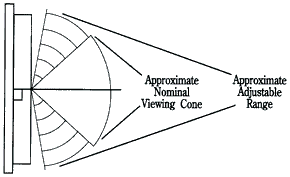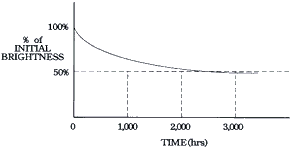
TN Viewing Cone
Alpha-numeric modules display characters, numerals, symbols and some limited graphics. Interface is achieved via a bi-directional, parallel ASCII data bus. Necessary features such as Character Generation, Display RAM Addressing, Cursor Scrolling, Blanking, and Handshake are all included. User programmable fonts are supported. In summary, these modules are the simplest and most economic means to communicate meaningfully between any micro-system and the outside world. Their inclusion adds to any product's appeal.
Alpha-numeric modules range from 8 to 80 characters per line. One, two or four character lines may be chosen. Character height spans 0.130" (3.31 mm) to 0.500" (12.71 mm). Most formats are available in a variety of packages to meet various mounting requirements. Multi-line models offer the best value when analyzed by a "cost per character" basis. Displays are readable both day and night by selecting a backlight option. Extended temperature modules are available which operate between -20 and +70C.
For requirements of more than 4 lines or 40 characters across, select a graphic formatted module. Graphic modules are also used when different sized characters are needed, and when special fonts such as Chinese or Arabic are required.
Selecting the exact version of an LCD once the format is decided is largely a subjective judgement. Color, fluid type, and backlighting determine the overall look of the display and often the appearance of the end product. Operating conditions such as temperature, lighting conditions, and available power are also factors in determining the type of display to use.
The following sections explains the optical characteristic options available in A/N modules,
TN Fluid
TN Fluid is the least expensive type. The viewing angle is about 40-45,
and must be designated "top" or "bottom" view preference. Bottom view
is used when the user will be below the plane perpendicular to the display, such as on a
desk calculator. Top view is used when the display is mounted on a vertical surface below
eye level. See diagram below.

TN Viewing Cone
STN AND NTN Fluid
STN and NTN are both high contrast and wide viewing angle fluids. They
differ in the level of contrast and viewing angle they achieve. Both can be seen above and
below the plane perpendicular to the display. See the diagram below.

NTN and STN Viewing Cone
The vertical viewing cone on all fluids can be adjusted by controlling the VO voltage. The range of adjustment is shown in the viewing angle charts below. The horizontal cone is relatively fixed.
| Fluid Type | Typical Contrast Ratio | Typical Viewing Angle |
|---|---|---|
| TN | 3:1 | 40-45o |
| NTN | 7:1 | 60o |
| STN | 10:1 | 75o |
The fluid type, polarizers and module construction determine the viewing mode and colour of the display. Displays are either "postive image", dark characters on a light background; or "negative image", light characters on a dark background. Backlight capability is determined by the presence or absence of a reflector or transflecter on the back side of the glass.
Reflective displays have a full reflector. The cannot be backlit. They offer the lowest power option and the best contrast in high ambient light conditions. They are not available in "positive image".
Transmissive displays are usually negative image and are backlit for best readability. They can be used in well lit indoor conditions to dark environments, typically not recommeded for daylight usage. They offer a different appearance than typical LCDs, bringing a light emitting look to the product.
Transflective displays combine the features of reflective and transmissive modes. These positive image displays can be read in all lighting conditions. The backlight can be turned on for low light levels or operated continuously to add the light-emitting look to a product.
 |
 |
| Positive Image | Negative Image |
Colors
TN positive image displays will have a silver/grey background and dark, almost black characters. In the negative image, the background will be black and the characters will be the color of the backlight, usually yellow/green or white. (See section on backlighting).
NTN and STN positive image displays can have a silver or yellow background with dark characters. Negative image versions have a dark blue background, characters are the folour of the backlight.
Choice of color is determined by what fits best in the package. Not all NTN displays are available in all colors. Consult us for current availability.
1) EL Backlighting
EL backlighting is the original LCD backlight. It is thin, lightweight, low power, and fits between the glass assembly and PCB without any modification to the module. Most positive mode displays are furnished with a blue green lamp. Negative mode displays usually come with a white lamp. Other colors can be specially ordered.
EL lamps operate from an AC power source, typically 400Hz at 70-110 VAC. We supply a full range of DC to AC inverters to power the lamps from a +5VDC source. There is no hard and fast rule for matching an inverter to a specific lamp. Lamp brightness and life are inversely proportional. That is the harder the lamp is driven the brighter it will be, but the shorter the life. Under rated operating conditions lamp life is about 2,000 to 2,500 hours to half its original brightness. Operating conditions such as temperature and humidity will also effect lamp life. The graph below illustrates the brightness vs life curve.

TYPICAL EL LAMP LIFE
Recommended inverters for various sizes of modules are shown below. Design considerations such as the operating conditions, desired brightness, required light, and lamp life must be balanced when designing with EL backlighting. For example, a negative transmissive display used in normal room lighting may look better when driven with a larger inverter but useful life will be shortened.
| Inverter Model | Displays |
|---|---|
| DAS5V4 | All A/N Displays except 4x40, 2x40, LM300 & LM4700 Series |
| DAS5V7 | 4x40, 2x40, LM300 & LM700 Series Transflective |
| DAS5V8 | 4x40, 2x40, LM300 & LM700 Series Transflective |
2) LED Backlighting
LED backlighting offers a significant life advantage over EL lamps, but at the sacrifice of power and module size. Lamp life is in excess of 50,000 hours, and in most cases, 1 lamp failing does not make the backlight unusable. LED backlit does not make the backlight unusable. LED backlit modules are 2-4mm thicker than an EL or non-backlit module. Standard color is yellow-green. Red amber and other colors may be specially ordered.
 |
 |
| Edgelit Style | Array Style |
LED Backlight Functional Diagram
We offer two types of LED backlights; edgelit and array. Their basic format is shown above.
Edgelit can be used on modules up to 20 characters wide. Beyond 20 characters, the middle of the display begins to dim when compared to the edges. (The LM43X series uses a top mounted edgelight to achieve its balance of light and power). Edgelight is the lower power of the two types. The 4XXX series edgelit modules typically operate 30 to 60mA(at +5VDC) and come with a built in current limit resistor. The 43X series is somewhat higher and must have a limited resistor in series for proper operation.
Array backlighting produces a brighter and more even light. Power is the main consideration when designing with this type of module. It is not recommended for battery powered applications where the lamp will be on all the time. (It may be suitable for "on demand" applications).
Limit resistors must be used for array backlit modules and the LM43X series. Refer to the specific module specification for recommended and/or maximum backlight ratings. LEDs are arranged in serial pairs and operated in parallel (see diagram). The lamp will require 4.2VDC. Brightness can be set or controlled by selecting the proper limit resistor. Select a resistor that will drop the remaining voltage at the desired current. For example, if 200mA produces the desired brightness and the supply voltage is +5VDC, the limit resistor will drop 0.8VDC (5.0 - 4.2). Therefore, E/I = R = 0.8/0.2 - 4ohms.
Variable brightness can be controlled with a digital potentiometer or pulse-width modulated circuit.